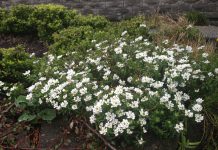
When the huge numbers of California Tortoiseshell butterflies showed up around here on June 10, I learned a lot about the different species of ceanothus and how dependent we are on this plant. Because most of us live near or in a Wildland Urban interface, we are aware of the benefits of ceanothus and other native plants. From erosion control to habitat, to seed and nectar for pollinators, birds and butterflies, ceanothus is a most valuable plant. A visit to any local nursery will tempt you to get one of each for your own garden. But are cultivars or “nativars” of ceanothus as valuable as native ceanothus?
Research is ongoing, but there are only a few studies comparing the nutritional value of straight native species to cultivars or nativars. Many may have as high an ecological value as native species, but this is not absolute. Dark foliage, for instance, does not provide the nutritional value for leaf-eating larvae. There is so much that we need to study.
The groundcover varieties I have used in landscape include Anchor Bay, Carmel Creeper, Heart’s Desire, Centennial and Diamond Heights. If deer frequent your landscape you should stick with Anchor Bay, Heart’s Desire and Centennial but the others are great in protected areas.
One of the upright types growing everywhere in the Santa Cruz Mountains is ceanothus thysiflorus. It’s one of the earliest native shrubs to bloom in our area. It grows along a narrow band close to the coast from Monterey to southern Oregon. There are many nativars of this variety. I like Julia Phelps with those electric blue flowers. It’s a hybrid of Wartleaf Ceanothus and Santa Barbara Ceanothus It’s similar in appliance to another popular nativar called “Dark Star.”
A great variety I often use when designing a garden is Ceanothus “Concha” because it will accept summer water more forgivingly than most and tolerates clay soil more than other species. Joyce Coulter ceanothus also tolerates clay, summer irrigation and shearing better than other cultivars. It’s a good bloomer, drought tolerant and is covered in spring with wildly fragrant blue three-inch flower spikes.
Ceanothus is often said to be short lived. Most varieties need good drainage, little summer water and don’t need soil amendments. In their wild conditions ceanothus plants have a natural life cycle of 10-15 years although some live longer.
Several members of the ceanothus family can form a symbiotic relationship with soil micro-organisms and fungi, forming root nodules which fix nitrogen. This is a reason why fertilizing is not normally recommended. Adding fertilizer might kill off the good micro-organisms. Ceanothus are better left fending for themselves.
Ceanothus provide excellent habitat for birds and insects. They are good for attracting bees and pollinators and are the larval host plants for the beautiful ceanothus silkmoth. Ceanothus seed is readily eaten by many local birds. Planting a ceanothus is an important step to attracting more birds and wildlife to your garden.
Early California Indians used the fresh or dried flowers of some varieties for washing, lathered into a soap. It has been said to relieve poison oak, eczema and rash.
Jan Nelson, a landscape designer and California-certified nursery professional, will answer questions about gardening in the Santa Cruz Mountains. Email her at ja******@*ol.com, or visit jannelsonlandscapedesign.com.












